 W
WThe White River is a Missouri River tributary that flows 580 miles (930 km) through the U.S. states of Nebraska and South Dakota. The name stems from the water's white-gray color, a function of eroded sand, clay, and volcanic ash carried by the river from its source near the Badlands. Draining a basin of about 10,200 square miles (26,000 km2), about 8,500 square miles (22,000 km2) of which is in South Dakota, the stream flows through a region of sparsely populated hills, plateaus, and badlands.
 W
WArchaeotherium is an extinct genus of entelodont artiodactyl endemic to North America and Eurasia during the Eocene and Oligocene epochs (33.9—24.8 mya), existing for approximately 9.1 million years .
 W
WBathornis is an extinct lineage of birds related to modern day seriemas, that lived in North America about 37–20 million years ago. Like the closely related and also extinct phorusrhacids, it was a flightless predator, occupying predatory niches in environments classically considered to be dominated by mammals. It was a highly diverse and successful genus, spanning a large number of species that occurred from the Priabonian Eocene to the Burdigalian Miocene epochs.
 W
WBathornithidae is an extinct family of birds from the Eocene to Miocene of North America. Part of Cariamiformes, they are related to the still extant seriemas and the also extinct Phorusrhacidae. They were likely similar in habits, being terrestrial, long-legged predators, some of which attained massive sizes.
 W
WBlastomeryx is an extinct genus of musk deer endemic to North America. It lived during the Miocene epoch 20.4—10.3 mya, existing for approximately 10 million years . There may be only one species, Blastomeryx gemmifer.
 W
WCynodesmus is an extinct genus of omnivorous canine which inhabited North America during the Oligocene living from 33.3—-26.3 Ma and existed for approximately 7 million years .
 W
WDaeodon is an extinct genus of entelodont artiodactyl that inhabited North America between 29 and 15.97 million years ago during the middle Oligocene and early Miocene epochs. It had a broad distribution across the United States, but it was never abundant. The type species is Daeodon shoshonensis, the last and possible largest of the entelodonts; known adults of this species possessed skulls about 90 cm (3 ft) in length.
 W
WThe Daphoeninae are an extinct subfamily of dog-like, terrestrial carnivores, which belonged to the family Amphicyonidae of the suborder Caniformia. The group inhabited North America from the Middle Eocene subepoch to the Middle Miocene subepoch 42—15.97 million years ago (Mya), existing for about 26.03 million years .
 W
WDaphoenus is an extinct genus of bear dogs. Daphoenus inhabited North America from the Middle Eocene to the Middle Miocene, 37.2—16.0 Mya, existing for approximately 21 million years .
 W
WDiceratherium is an extinct genus of rhinoceros endemic to North America, Europe, and Asia during the Oligocene through Miocene living from 33.9—11.6 mya, existing for approximately 22.3 million years . Mass estimates for the type species, D. armatum average around 1 t (2,200 lb)
 W
WDinictis is a genus of the Nimravidae, an extinct family of feliform mammalian carnivores, also known as "false saber-toothed cats". Assigned to the subfamily Nimravinae, Dinictis was endemic to North America from the Late Eocene to Early Miocene epochs, existing for about 16.8 million years .
 W
WEnhydrocyon is an extinct genus of bone crushing canid which inhabited North America during the Oligocene and Early Miocene, 30.8—20.4 Ma, existing for approximately 11 million years .
 W
WEporeodon is an extinct genus of oreodont belonging to the family Merycoidontidae. It lived from the Oligocene epoch 30.8—24.8 mya) existing for approximately 6 million years .
 W
WGomphotherium is an extinct genus of proboscids from the Neogene and early Pleistocene of Eurasia, Africa, North America and possibly also Asia.
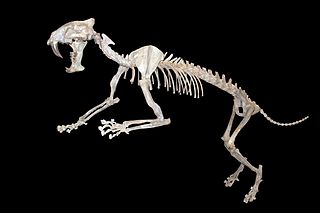 W
WHoplophoneus is an extinct genus of the family Nimravidae, endemic to North America during the Late Eocene to Early Oligocene epochs, existing for approximately 6 million years.
 W
WHyaenodon ("hyena-tooth") is the type genus of the Hyaenodontidae, a family of extinct carnivorous fossil mammals from Eurasia, North America, and Africa, with species existing temporally from the Eocene until the middle Miocene, existing for about 26.1 million years .
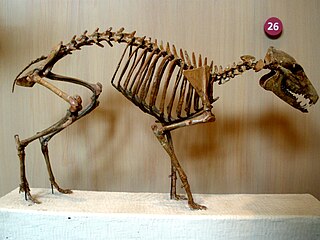 W
WHypertragulus is an extinct genus of hypertragulid ruminant endemic to North America. It lived from the Late Eocene to the Middle Miocene, living 37.2 to 16 million years ago, existing for approximately 11 million years .
 W
WHyracodon is an extinct genus of mammal.
 W
WIschyromys is an extinct genus of rodent from North America.
 W
WLeptauchenia is an extinct goat-like genus of terrestrial herbivore belonging to the oreodont family Merycoidodontidae, and the type genus of the tribe Leptaucheniini. The genus was endemic to North America during the Late Oligocene to Early Miocene and lived for approximately 17.6 million years .
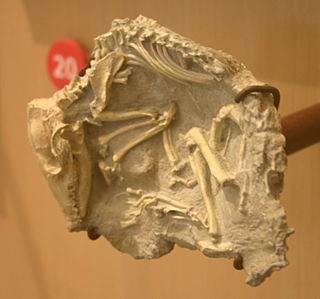 W
WLeptictis is an extinct genus of mammal. It was related to the better-known Leptictidium.
 W
WLeptomeryx is an extinct genus of ruminant of the family Leptomerycidae, endemic to North America during the Eocene through Oligocene 38–24.8 Mya, existing for approximately 13.2 million years . It was a small deer-like ruminant with somewhat slender body.
 W
WMegacerops is an extinct genus of the prehistoric odd-toed ungulate family Brontotheriidae, an extinct group of rhinoceros-like browsers related to horses. It was endemic to North America during the Late Eocene epoch, existing for approximately 4.1 million years .
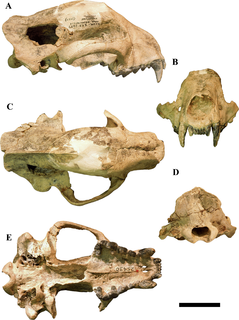 W
WMegalictis is an extinct genus of large predatory mustelids, which existed in North America during the "cat gap" in the Miocene epoch. It is thought to have resembled a large wolverine, with a body mass of up to 60 kilograms (130 lb).
 W
WMerycoidodon is an extinct genus of herbivorous artiodactyl of the family Merycoidodontidae, more popularly known by the name Oreodon. It was endemic to North America during the Late Eocene to Early Miocene existing for approximately 30 million years .
 W
WMerycoidodontoidea, sometimes called "oreodonts" or "ruminating hogs", is an extinct superfamily of prehistoric cud-chewing artiodactyls with short faces and fang-like canine teeth. As their name implies, some of the better known forms were generally hog-like, and the group has traditionally been placed within the Suina, though some recent work suggests they may have been more closely related to camels. "Oreodont" means "mountain teeth", referring to the appearance of the molars. Most oreodonts were sheep-sized, though some genera grew to the size of cattle. They were heavy-bodied, with short four-toed hooves and comparatively long tails.
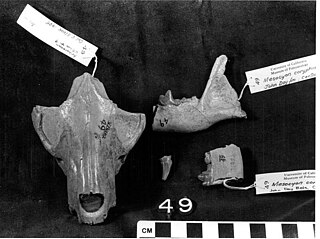 W
WMesocyon is an extinct genus of the Hesperocyoninae subfamily of early canids native to North America. It lived from the Oligocene to Early Miocene, 30.3—20.3 Ma, existing for approximately 10 million years . Fossils are known from Oregon, southern California and the northern Great Plains. It was roughly coyote-sized, and the first known canid to have a primarily meat-based diet.
 W
WMesohippus is an extinct genus of early horse. It lived some 40 to 30 million years ago from the Middle Eocene to the Early Oligocene. Like many fossil horses, Mesohippus was common in North America.
 W
WMesoreodon is an extinct genus of terrestrial herbivore of the family Merycoidodontidae, subfamily Merycoidodontinae, endemic to North America during the Whitneyan stage of the Oligocene-Miocene epochs existing for approximately 12.4 million years .
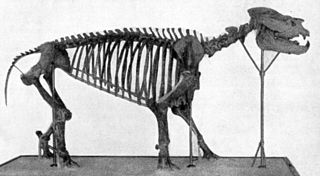 W
WMetamynodon is an extinct genus of amynodont rhino that lived in North America and Asia from the late Eocene until early Oligocene, although the questionable inclusion of M. mckinneyi could extend their range to the Middle Eocene. The various species were large, displaying a suit of semiaquatic adaptations similar to those of the modern hippopotamus despite their closer affinities with rhinoceroses.
 W
WMoropus is an extinct genus of perissodactyl mammal that belonged to the group called chalicotheres. They were endemic to North America during the Miocene from ~20.4—13.6 Mya, existing for approximately 6.8 million years .
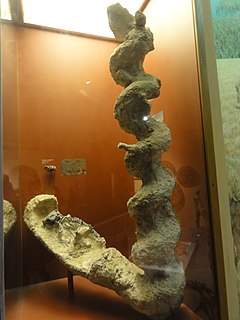 W
WPalaeocastor is an extinct genus of beavers that lived in the North American Badlands during the late Oligocene period. Paleocastor was much smaller than modern beavers.
 W
WPalaeolagus is an extinct genus of lagomorph. Palaeolagus lived in the Oligocene period which was about 33-23 million years ago. The earliest leporids described from the fossil record of North America and Asia date to the upper Eocene some 40 million years ago.
 W
WParahippus is an extinct equid, a relative of modern horses, asses and zebra. It was very similar to Miohippus, but slightly larger, at around 1 metre tall, at the withers.
 W
WPoebrotherium is an extinct genus of camelid, endemic to North America. They lived from the Eocene to Miocene epochs, 46.3—13.6 mya, existing for approximately 32 million years .
 W
WPromerycochoerus is an extinct genus of hippopotamus-like oreodont artiodactyl that lived in Central North America during the Early Miocene.
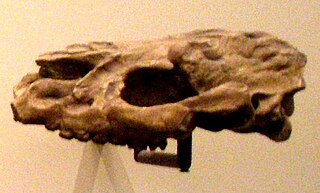 W
WProtapirus is an extinct genus of tapir. Fossil specimens of this genus have been found in North America and Europe.
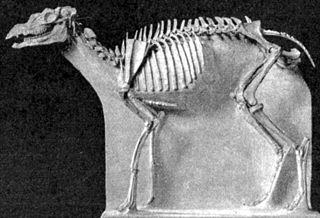 W
WProtoceras is an extinct genus of Artiodactyla, of the family Protoceratidae, endemic to North America. It lived from the Oligocene to the Early Miocene 33.3—16.0 Ma, existing for approximately 17 million years .
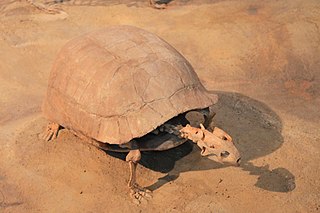 W
WStylemys is the first fossil genus of dry land tortoise belonging to the order Testudines discovered in the United States. The genus lived in temperate to subtropical areas of North America, Europe, and Asia, based on fossil distribution. The genus was first described in 1851 by Joseph Leidy. The tortoise was common in the prehistoric Badlands, especially Nebraska and South Dakota. The species has also been found in the formations in and around Badlands National Park. Fossil fragments have also been found in the Palm Park Formation of New Mexico.
 W
WSubhyracodon is an extinct genus of hornless rhinoceroses. With a length of 2.4 m (8 ft) and a weight estimated of 381.3 kg, it was a tapir-sized herbivore on the plains of early Oligocene South Dakota 33 million years ago. It coexisted with other perissodactyls such as horses, brontotheres, and chalicotheres. Subhyracodon had no horns, relying more on its speed to escape from predators, but a species found at Wind Cave National Park had a pair of bony nasal ridges. The genus Caenopus and species originally referred to as Aceratherium were synonymized into Subhyracodon.
 W
WSyndyoceras is a small extinct genus of Artiodactyla, of the family Protoceratidae, endemic to central North America from the Miocene epoch, existing for approximately 4.2 million years .
 W
WTemnocyon is an extinct genus of bear-dogs endemic to North America. It lived from the Oligocene to Early Miocene approximately 30.8—20.4 mya, existing for about 11 million years .
 W
WThe Temnocyoninae are an extinct subfamily of medium-sized bear dogs endemic to North America that lived during the Early Oligocene to Early Miocene about 30.8-20.43 million years ago (Mya) existing for around 10 million years.
 W
WTrigonias is an extinct genus of rhinoceros from the late Eocene (Chadronian) some 35 million years ago of North America . Trigonias was about 2.1 m (7 ft) long and, despite lacking horns, looked a lot like modern rhinos. Its front legs had five toes, the fifth of which was vestigial.